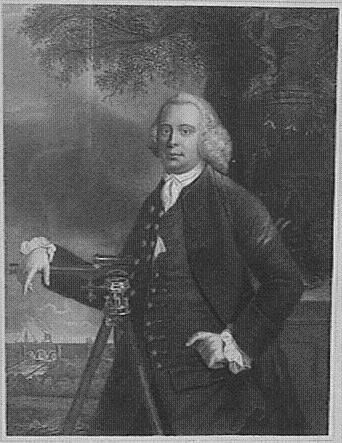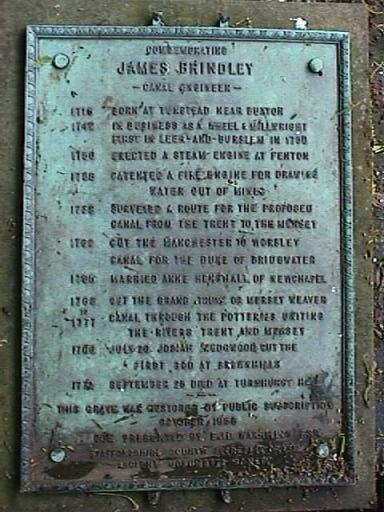
The most famous person to have lived in the Newchapel area was James Brindley, known for his contribution to the waterway system of this country. He was responsible for inventing canal locks, a model of which, he constructed in the garden at Turnhurst Hall (now demolished) which he rented from the Alsager family.
Josiah Wedgwood, the famous potter, took a great interest in his work, since with the construction of canals, an easy and smooth means of transport was provided between the Potteries and Liverpool for the growing pottery industry, to replace transport by pack horse along rough and muddy tracks.
On 8th December 1765 at St. Margarets Parish Church, Wolstanton, James Brindley married Anne Henshall, daughter of John Henshall, land surveyor who lived at Bent House (Packmoor - then known as Bent) New Chapel. Anne was just 19 years of age, whilst James was 49. They went to live at Turnhurst Hall which was a country mansion. It provided an ideal base for Brindleys activities, being close to his workshops in the nearby town of Burslem, the work he was doing at Goldenhill colliery and the forthcoming project of constructing the Grand Trunk Canal, which would connect the river Trent to the Mersey.
Unfortunately, the hall was demolished in 1929 and all that remained to show its location was a pond with an island in the middle, off Turnhurst Road. The model lock gates of James Brindley were removed to the science museum in London. A public house named 'Brindleys Lock' is now built on the site and other discovered remains of his work were removed to the local city museum.
Josiah Wedgwood and the management trust of the Trent and Mersey Canal Company decided to construct a branch canal from the summit at Etruria, Stoke-on-Trent, to Froghall in the valley of the river Churnet. Brindley surveyed the route and in September 1772 had reached Froghall. He got soaked to the skin, caught a chill, was taken to an inn in the village of Ipstones nearby and put into a damp bed. He became seriously ill and was taken to his home at Turnhurst. The eminent scientist and physician Erasmus Darwin, friend of Josiah Wedgwood, and the grandfather of Charles Darwin was called in. He diagnosed the malady that had troubled Brindley for several years as diabetes.
It was now too late, the patient was beyond human help. On September 26th 1772 Wedgwood wrote to his partner Thomas Bentley: "Poor Mr. Brindley has nearly finished his course in this world. He says he must leave us, and indeed I do not expect to find him alive in the morning. His disorder, I think I told you, is a diabetes, and this malady he has had upon him for seven years past most probably, which occasioned his constant fever and thirst, though I believe not one of his doctors found it out till Dr Darwin discovered it in the present illness, which, I fear, will deprive us of a valuable friend, and the world of one of the great Geniuses who seldom live to see justice done to their singular abilities, but must trust to future ages for that tribute of praise and fair fame they so greatly merit from their fellow mortals."
On September 28th 1772 Wedgwood wrote again: "I told you in my last letter that Brindley was extremely ill, and I have the grief to tell you that he is now no more. He died on the 27th inst. about 12 noon, after giving him something to wet his mouth, he said, "It's enough, I shall need no more", and shut his eyes, never more to open."
So, James Brindley died in 1772 and did not live to see his dream of tunnelling through Harecastle Hill realised. The work was completed by his brother-in-law.
He left a young widow, Anne and two daughters. Anne married Robert Williamson in 1775 and had seven children. She died in 1799. Of Brindley's two daughters, Susannah married John Bettington in 1795 and they emigrated to Australia, had children and lived at Brindley's Plains, Tasmania. Anne, the other daughter, died on the voyage home from Sydney, Australia in 1838.
James Brindley was buried in the churchyard on September 30th 1772 and the present church (St James) at Newchapel is dedicated to his memory. His grave lies within the churchyard, just off the main drive on the left-hand side by the trees. The grave was originally marked by a raised stone tomb surrounded by metal railings. In the 1950's it needed to be repaired and was restored in 1956 by public subscription. This raised stone tomb is now gone and the flat stone slab laid at ground level. The grave is marked by a bronze plaque, given by local historian Mr. E.J.D. Warrilow. The plaque lists the significant dates and achievements in the life of this great engineer.
A small print of James Brindley (as shown at the top of this page) hangs in the inner porch of St James in the main entrance. The 'Brindleys Lock' public house has photographs of Turnhurst Hall and prints of James Brindley hanging on the walls in the public bar.
Josiah Wedgwood, the famous potter, took a great interest in his work, since with the construction of canals, an easy and smooth means of transport was provided between the Potteries and Liverpool for the growing pottery industry, to replace transport by pack horse along rough and muddy tracks.
On 8th December 1765 at St. Margarets Parish Church, Wolstanton, James Brindley married Anne Henshall, daughter of John Henshall, land surveyor who lived at Bent House (Packmoor - then known as Bent) New Chapel. Anne was just 19 years of age, whilst James was 49. They went to live at Turnhurst Hall which was a country mansion. It provided an ideal base for Brindleys activities, being close to his workshops in the nearby town of Burslem, the work he was doing at Goldenhill colliery and the forthcoming project of constructing the Grand Trunk Canal, which would connect the river Trent to the Mersey.
Unfortunately, the hall was demolished in 1929 and all that remained to show its location was a pond with an island in the middle, off Turnhurst Road. The model lock gates of James Brindley were removed to the science museum in London. A public house named 'Brindleys Lock' is now built on the site and other discovered remains of his work were removed to the local city museum.
Josiah Wedgwood and the management trust of the Trent and Mersey Canal Company decided to construct a branch canal from the summit at Etruria, Stoke-on-Trent, to Froghall in the valley of the river Churnet. Brindley surveyed the route and in September 1772 had reached Froghall. He got soaked to the skin, caught a chill, was taken to an inn in the village of Ipstones nearby and put into a damp bed. He became seriously ill and was taken to his home at Turnhurst. The eminent scientist and physician Erasmus Darwin, friend of Josiah Wedgwood, and the grandfather of Charles Darwin was called in. He diagnosed the malady that had troubled Brindley for several years as diabetes.
It was now too late, the patient was beyond human help. On September 26th 1772 Wedgwood wrote to his partner Thomas Bentley: "Poor Mr. Brindley has nearly finished his course in this world. He says he must leave us, and indeed I do not expect to find him alive in the morning. His disorder, I think I told you, is a diabetes, and this malady he has had upon him for seven years past most probably, which occasioned his constant fever and thirst, though I believe not one of his doctors found it out till Dr Darwin discovered it in the present illness, which, I fear, will deprive us of a valuable friend, and the world of one of the great Geniuses who seldom live to see justice done to their singular abilities, but must trust to future ages for that tribute of praise and fair fame they so greatly merit from their fellow mortals."
On September 28th 1772 Wedgwood wrote again: "I told you in my last letter that Brindley was extremely ill, and I have the grief to tell you that he is now no more. He died on the 27th inst. about 12 noon, after giving him something to wet his mouth, he said, "It's enough, I shall need no more", and shut his eyes, never more to open."
So, James Brindley died in 1772 and did not live to see his dream of tunnelling through Harecastle Hill realised. The work was completed by his brother-in-law.
He left a young widow, Anne and two daughters. Anne married Robert Williamson in 1775 and had seven children. She died in 1799. Of Brindley's two daughters, Susannah married John Bettington in 1795 and they emigrated to Australia, had children and lived at Brindley's Plains, Tasmania. Anne, the other daughter, died on the voyage home from Sydney, Australia in 1838.
James Brindley was buried in the churchyard on September 30th 1772 and the present church (St James) at Newchapel is dedicated to his memory. His grave lies within the churchyard, just off the main drive on the left-hand side by the trees. The grave was originally marked by a raised stone tomb surrounded by metal railings. In the 1950's it needed to be repaired and was restored in 1956 by public subscription. This raised stone tomb is now gone and the flat stone slab laid at ground level. The grave is marked by a bronze plaque, given by local historian Mr. E.J.D. Warrilow. The plaque lists the significant dates and achievements in the life of this great engineer.
A small print of James Brindley (as shown at the top of this page) hangs in the inner porch of St James in the main entrance. The 'Brindleys Lock' public house has photographs of Turnhurst Hall and prints of James Brindley hanging on the walls in the public bar.
Copyright © St James 2002 - 2026
Website design by KiiRO Creative



